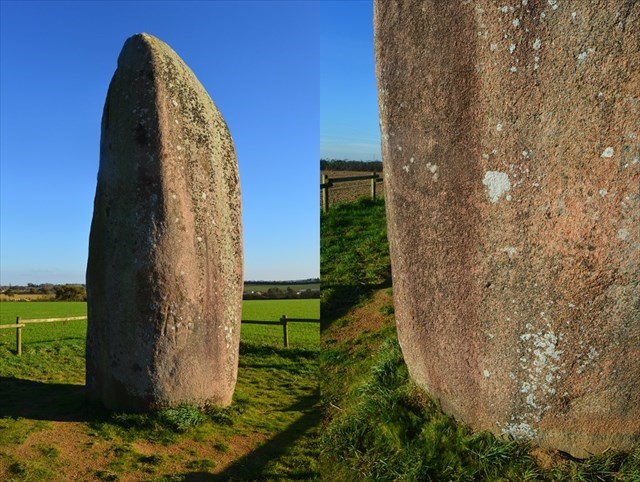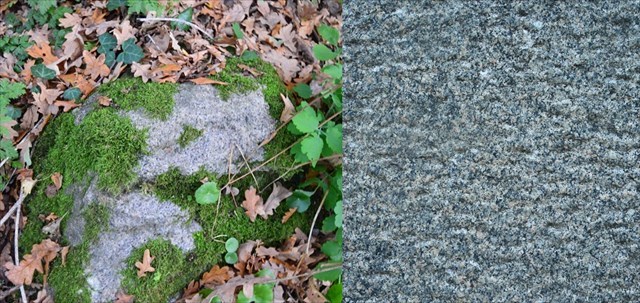Cette cache est une petite promenade géologique au parc de Moine, vous pourrez y découvrir quelques échantillons de roches, dont du granite souvent présent dans le sous-sol des Mauges. Vous passerez également devant 2-3 caches, dont la multi du parc, n'hésitez pas à la faire en même temps !
This cache is a geological walk in the parc de Moine, you will see some different rocks, and among those some granite, which is often present in the subsoil of the Mauges. You will also go besides other caches, and amongthose the multicache of the park, do not hesitate to try it at the same time.
Le granite / Granite
Le granite est une roche plutonique magmatique à texture grenue. Il est composé de minéraux, en grande majorité de quartz, de micas et de feldspaths. Cette roche est le résultat du refroidissement lent, en profondeur, de grandes masses de magma intrusif qui formeront le plus souvent des plutons, ces derniers affleurant actuellement en surface, grâce au jeu de l'érosion qui a décapé les roches sus-jacentes. Ces magmas acides (c'est-à-dire relativement riches en silice) sont essentiellement le résultat de la fusion partielle de la croûte terrestre continentale.
Granite is a common type of felsic intrusive igneous rock that is granular and phaneritic in texture. These rocks mainly consist of feldspar, quartz, and mica. This rock is the result of slow cooling, much under the Earth's crust, of big quantity of intrusive magma which will mostly create plutons, and these ones are now present as outcrops, due to the erosion which removed the rocks over. These acid magmas (this means they consist of much silica) are essentially the result of the partial fusion of the Earth's crust.
L'orthose / orthoclase
Le granite peut avoir différentes teintes, ce sont les feldspaths qui le composent qui déterminent sa couleur. Et notamment un type de Feldspaths, l'orthose, peut être blanchâtre ou avoir une teinte rose (ceci étant dû à la présence d'oxyde de fer). L'orthose (terme français) ou l'orthoclase (terme international) est une espèce minérale du groupe des silicates sous groupe des tectosilicates, famille des feldspaths sous-famille des feldspaths potassiques. Sa composition chimique est KAlSi3O8 avec des traces de Na;Fe;Ba;Rb;Ca.
Ainsi à Saint-Macaire-en-Mauges, où se trouve le fameux menhir de la Bretellière, le granite contient de l'orthose avec des traces de fer et sa couleur dominante est le rose :
Granite may be of different colors, because of the feldspars present in the rock. And more accurately a type of feldspar, the orthoclase, may be pink or white (pink when iron oxyds are present). Orthoclase, or orthoclase feldspar (endmember formula KAlSi3O8), is an important tectosilicate mineral which forms igneous rock (it may also consist of some Na;Fe;Ba;Rb;Ca). The name is from the Greek for "straight fracture," because its two cleavage planes are at right angles to each other. It is a type of potassium feldspar, also known as K-feldspar.
In Saint-Macaire-en-Mauges, where you can find the famous menhir de la Bretellière, the granite contains some iron with orthoclase, and its main color is pink:

À Vezins, c'est un granite gris que l'on trouve en affleurements :
In Vezins, it's the grey granite that can be found in outcrops:

Questions :
Question 1 : Rendez-vous aux coordonnées : N 47° 03.327 W 000° 52.604. Vous avez à proximité un gros rocher. Décrivez sa texture, son aspect et sa couleur. Est-ce du granite ? Si non, de quelle roche s'agit-il (Grès ? Micaschiste ? Gneiss ?) ? Contient-elle de l'orthose rose ?
Question 2 : Rendez-vous aux coordonnées : N 47° 03.114 W 000° 52.445. Vous avez à proximité un gros rocher de granite. Contient-il de l'orthose rose ?
Question 1: Go to the coordinates: N 47° 03.327 W 000° 52.604. You will find a big rock near this point. Describe its texture, its aspect and its color. Is it some granite? If not, which rock is it (Sandstone? Micaschist? Gneiss?)? Does it consist of pink orthoclase?
Question 2: Go to the coordinates: N 47° 03.114 W 000° 52.445. You will find a granite rock near this point. Does it consist of pink orthoclase?
Pour loguer / How to log
Loguez cette cache "Found it" et envoyez-moi vos propositions de réponses soit via mon profil, soit via la messagerie geocaching.com (Message Center), et je vous contacterai en cas de problème.
Once you have come and got the answers, you can log "found it" and send me your answers either using the email in my profile or using the geocaching.com message center, then I will contact you if there is a problem.
Bon earthcaching à tous ! Happy earthcaching!